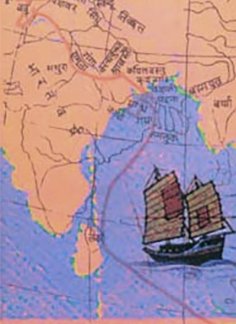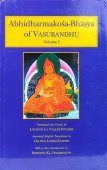Hsuan-tsang, Hsüan-tsang: 3 definitions
Introduction:
Hsuan-tsang means something in Buddhism, Pali, the history of ancient India. If you want to know the exact meaning, history, etymology or English translation of this term then check out the descriptions on this page. Add your comment or reference to a book if you want to contribute to this summary article.
In Buddhism
Theravada (major branch of Buddhism)
Source: Pali Kanon: Pali Proper NamesHsuen Tsang A painting from a Chinese Monastery. Courtesy: D. Mitra, Buddhist Monuments.
A well known Chinese monk who visited India and traversed a large number of countries covering more than 50,000 Li. Though the dangers that he encountered were many he fulfilled his main objective undaunted by them. His contribution to the cause of Buddhism in general and to the Great Vehicle in particular is immense. For these and many other reasons he is held by the Chinese Buddhists in the highest esteem among the pilgrims of his calibre. The following information on Hsuan tsangs travels and his accounts of India and other countries which he travelled in his long journey is based mainly on two sources, namely, Si yu ki, Buddhist Records of the Western World an English translation of the Chinese version of Hsuan tsang and The Life of Hiuen tsiang an English translation of his biography written in Chinese by Shaman Hwui li, a disciple of his. Among secondary sources the most useful treatise is On Yuan Chwangs Travels in India, a critical study written by Thomas Watters in 1961. This work is based on Hsuan tsangs Hsi Yu Shi (or Si Yu Ki) also entitled Buddhist Records of the Western World. Hsuan tsang was born in 603 A.C. in Chin lu in the reign of Emperor Wen of the Sui dynasty and lived about sixty five years. Opinions, however, differ regarding the exact years of his birth and death. His secular name was Chen Chin and he was the youngest of four brothers. His father was Chen hui who devoted himself to the study of Confucious teachings. Even as a child Hsuan tsang was unusually of grave temperament and intelligence. He did not enjoy the company of boys of his age nor did he appreciate their life style. His second brother, Chang tse who had entered the Order previously took Hsuan tsang to his own convent and made arrangements to impart instruction to him there.
Hsuan tsang (= Ht.) was so studious that at times he studied without sleep and even food. At one hearing he is said to have comprehended a book thoroughly and after a second reading needed no further instruction. At the age of eleven he was versed in the Saddharmapundarika Sutra and the Vimalakirtinirdesa. At the age of thirteen he was admitted into the Order and was engaged in further studies.
The political situation in the country being unsatisfactory the two brothers went to Changan and from there again to Cheng tu, the capital of Shu. There Hsuan tsang followed lectures on the scriptures delivered by eminent scholars and in a few years he mastered the scriptures of various schools and earned a name as a scholar. It was about this time or a few years later that he came to be known by the appellation The Master of the Law.
In the fifth year of Wu te he received full ordination at Cheng tu.
Theravāda is a major branch of Buddhism having the the Pali canon (tipitaka) as their canonical literature, which includes the vinaya-pitaka (monastic rules), the sutta-pitaka (Buddhist sermons) and the abhidhamma-pitaka (philosophy and psychology).
General definition (in Buddhism)
Source: Buddhist Door: GlossaryA famous translator in Chinese Buddhism, next to Kumarajiva. He translated more scriptures than any other translators, such as: * Mahaprajnaparamita Sutra, i.e. Great Perfection of Wisdom Sutra ( ), 600 fasicles translated in 660-663 A.D. * Vijnaptimatratasiddhi shastra (Treatise on the Establishment of the Doctrine of Mere Consciousness) ( ), 10 fasciles translated in 659 A.D. * Mahayanabhidharma samucchaya (collection of the Mahaya Abhidharma) ( ), 7 fasciles in 652 A.D. * Mahayanabhidharma samucchaya vyakhya (Exeglsis on the collection of the Mahayana Abhidhin), 16 fasciles in 646 A.D. * Mahayanasamgraha (comprehensive Treatise on Mahayana Buddhism) ( ), 3 fasciles in 648-649 A.D. Hsuan tsang was born into a family of scholars near Loyang ( ), but his father did not want to serve the new king, then became poor. In order to make a living, Tsuan tsang followed the step of his elder brother to become ordained monk when he was a child. However, when he was eleven, he was able to read the Vinalakirti Sutra, the Lotus Sutra, etc. He was brought up at Hui jih Temple in Loyang. Later, he went to Chuang yen Temple in Chang an in search of better teachers, but in vain. Because of famine, Tsuan tsang settled in Szechuan Province and continued his study in Buddhism. He kept on seeking for better teachers, but found no more outstanding scholars. In 629, when Hsuan tsang was around thirty, he set out to the west for travel and study. In his travels, he had recorded all his experience in India and Central Asia in details, which had important information on geography, history, politics, economics, culture of that time.India history and geography
Source: Wikipedia: India HistoryHsüan-tsang is an alternative transliteration for Xuanzang (c. 602-664 A.D.): a Chinese Buddhist monk, scholar, traveler, and translator who traveled to India in the seventh century and described the interaction between Chinese Buddhism and Indian Buddhism during the early Tang dynasty. Hsüan-tsang (Xuanzang) became famous for his seventeen-year overland journey to India (including Nalanda), which is recorded in detail in the classic Chinese text “Great Tang Records on the Western Regions”.

The history of India traces the identification of countries, villages, towns and other regions of India, as well as mythology, zoology, royal dynasties, rulers, tribes, local festivities and traditions and regional languages. Ancient India enjoyed religious freedom and encourages the path of Dharma, a concept common to Buddhism, Hinduism, and Jainism.
See also (Relevant definitions)
Full-text: Puri, Sthaneshvara, Maha Prajna Paramita Sutra, Untranslated Terms, Purushapura, Nalanda, Purnagiri, Puniagiri, Punyagiri, Pushpagiri, Amara Sinha.
Relevant text
Search found 10 books and stories containing Hsuan-tsang, Hsüan-tsang; (plurals include: tsangs). You can also click to the full overview containing English textual excerpts. Below are direct links for the most relevant articles:
A Blessed Pilgrimage (by Dr. Yutang Lin)
Stupas in Orissa (Study) (by Meenakshi Chauley)
Symbolism of the Stupa < [Chapter 3]
Development of Stupa Architecture in India < [Chapter 3]
Impact of Vedic Culture on Society (by Kaushik Acharya)
Mingling of Cultures (I): The Puṣyabhūtis < [Chapter 4]
A comparative study between Buddhism and Nyaya (by Roberta Pamio)
2. Vasubandhu and His Works < [Chapter 3 - The Buddhist Theory of Perception]
3. Ācārya Diṅnāga and His works < [Chapter 3 - The Buddhist Theory of Perception]
Jain Remains of Ancient Bengal (by Shubha Majumder)
Geographical as well as Geo-political unit of Zone III < [Chapter 2 - Geographical Setting of the Study Area]
Geographical as well as Geo-political unit of Zone IV < [Chapter 2 - Geographical Setting of the Study Area]
Buddha-nature (as Depicted in the Lankavatara-sutra) (by Nguyen Dac Sy)
2.2. The Buddha-nature and Yogācāra < [Chapter 1 - Evolution of the Buddha-nature Concept]
Related products
